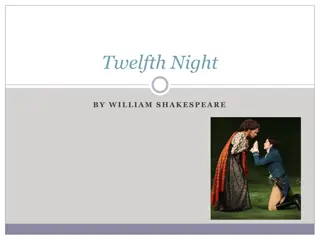Insights into Elizabethan Poetry: A Glance at the Golden Age
The Elizabethan Age, also known as the Age of Shakespeare, during Queen Elizabeth I's reign from 1558 to 1603, marked a golden era in English poetry. This period saw a flourishing of poetic forms influenced by Greek and Italian poetry. Major poets like Edmund Spenser, Sir Philip Sidney, and William Shakespeare contributed significantly to various lyrical and dramatic forms, reflecting themes of love, nature, patriotism, and more. The characteristics of Elizabethan poetry showcased a blend of delicate diction, pastoral elements, and a rich artistic expression that continue to be admired. The era was characterized by a spirit of independence and creativity, leading to a lasting impact on English literature.
Download Presentation

Please find below an Image/Link to download the presentation.
The content on the website is provided AS IS for your information and personal use only. It may not be sold, licensed, or shared on other websites without obtaining consent from the author. Download presentation by click this link. If you encounter any issues during the download, it is possible that the publisher has removed the file from their server.
E N D
Presentation Transcript
ELIZABETHAN POETRY Elizabethan Age also called Age of Shakespeare Reign of Queen Elizabeth-I - 1558-1603 William Shakespeare Span of Elizabethan Poetry- considered to be the second half of sixteenth century to first quarter of seventeenth century Elizabethan Age- golden age of English poetry Termed as veritable nest of singing birds Influence of Greek and Italian poetry - 1564-1616
Elizabethan Age: Contribution to Poetry Epic: Edmund Spenser s The Faerie Queene first attempt to write epic in modern English, based or Virgil s model Dramatic: Valuable and prolific contribution by The University Wits, William Shakespeare, Ben Jonson etc. to tragedy as well as comedy, poetic dramas Lyric: great influence of Greek and Italian poetry- many lyrical forms introduced in to English- sonnet, elegy, ode, song, ballad, madrigals, airs, roundelays etc.
Elizabethan Lyric: Characteristic Features Revival of interest in Greek literature: introduction of lyrical types like elegy, ode, ballad etc. and tempered and polished the rudeness of English literature Abundance of output: abundant output due to overall peace, harmony, stability and royal patronage Romantic zeal: quest for the remote, the wonderful and the beautiful, spirit of adventure, freshness Translations: translations from Greek, Latin, French helped introduce new poetic/ lyrical types Spirit of independence: despite borrowing from other European models, spirit of independence, creativeness and imagination seen
Characteristics continued Light, delicate diction Pastoral element Renaissance fancies, flights of imagination Rhythmical expression of personal/individual passion Sweet as well as melancholic notes Finer artistic feeling, grace, buoyancy, gravity Balance of form and expression Conventionality of themes Themes: love, praise of God, patriotism, war, revelry, rejoicing, pastoral piping joys of country life, ditties of careless delight, blithe praise of contentment and ease
Major lyrical poets of the Elizabethan age Edmund Spenser Sir Philip Sidney Michael Drayton Samuel Daniel William Shakespeare Ben Jonson
Conclusion Technically, Elizabethan Age ends with the death of Queen Elizabeth I (1603). But tendencies continue till the death of William Shakespeare (1616) Part of Jacobean Age (King James I) also included in Elizabethan Age John Milton actually belongs to Caroline Age (Charles I) but by temperament he was a child of Renaissance


![❤[READ]❤ Robotic Exploration of the Solar System: Part I: The Golden Age 1957-19](/thumb/21623/read-robotic-exploration-of-the-solar-system-part-i-the-golden-age-1957-19.jpg)




















